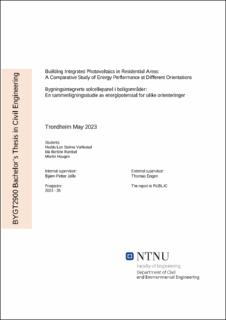| dc.description.abstract | The conducted study evaluates the variation of the solar irradiation accessibility in a consolidated Nordic built environment. The approach is applied to a case study located at the municipality of Ørland, Norway; latitude 63.7828° N. The objective is to examine the possibility of installing building integrated photovoltaics (BIPV) on one of the relocated cultural heritage houses, as well as analyse the solar irradiation accessibility on the building envelope. A series of solar simulations are conducted to determine the solar irradiation accessibility during different periods, using climate data as basis metric. The results show the variation of the solar accessibility between the astronomical seasons, and the annual irradiation incidence, on the building surfaces. In this context, the solar irradiations accessibility during winter and autumn are drastically lower than those during spring and summer, which negatively affect the energy production during those seasons. Furthermore, the simulation results indicate that the most optimal orientation for each of the building surfaces varies significantly according to the simulation periods. Hereby, the energy production can be maximised by finding the optimal orientation for each of the surfaces and subsequently determining the most optimal surfaces combination for BIPV panels installation. The findings from the conducted analyses, show that roof tiles BIPV installation would be optimal for annual energy production, while the BIPV panels installation on selected facade surfaces would maximise the energy production during the critical seasons, i.e. winter and autumn. Moreover, the calculated results for the total energy production, shows that covering the dwelling entire energy consumption is very challenging. This study demonstrates how the solar incidence varies correspondingly to the simulation period, and how this can affect the energy production. | |
